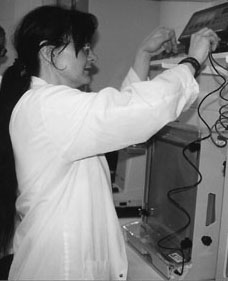
|
Fish lab finds family differences The stocks assessment and genetics unit is one of several Ministry of Natural Resources laboratories operating at Trent. This is the first in a series profiling MNRıs presence.
by Martha Tancock
Until the 1970s, government restocking programs might drop lake trout
from a Manitoba lake into a Haliburton lake. They were the same species
after all.
Now they know better. Biochemical genetics researchers like Bill Martin
and Wendy Stott in the Ministry of Natural Resourcesıs new fish laboratory
at Trent can tell you which Ontario lake a trout, whitefish, salmon or
walleye might have come from by analyzing their enzymes and genetic
makeup. Trout species even in neighboring lakes may look identical but they
have adapted since the ice age in subtle ways to the water chemistry, food
supply and spawning shoals peculiar to their home lake. And these ways may
be evident in their enzymes and genes.
As the ministry breeds these commercial fish to restock acid-damaged
and other lakes in Ontario, it tries to match as closely as possible the
stocks that were there before. For the past 20 years, Martin has been
developing comparative allozyme (enzymes that have different migration
rates when subjected to an electrical current) profiles of wild populations
of fish in Ontario. ³Itıs very useful information for managing stocks,²
says the senior research technician.
³Previously, we might have used to bring fish from out of province to
restock lakes. Fish were looked upon as a species with no special
differences,² said Martin. If those differences are not clear through
allozyme analysis, they can be identified by investigating fish DNA, or
genetic fingerprints, especially in species which tend to have less
variable allozymes such as pike. DNA is Stottıs expertise.
In restocking lakes to what they were before fish populations were
reduced or extinguished, ³we want to make sure the fish are genetically
similar,² says Martin. If the planted fish are really different, they may
not survive as well, they may do too well and overpower the native fish in
the lake or, if they come from a really narrow gene pool, they may not be
biodiverse enough to survive beyond the first few generations.
The lab also monitors the genetic variability of fish in the ministryıs
hatcheries using fin and muscle samples taken from living stock. Stott, a
contract research technician, checks for signs of inbreeding, which could
weaken the species. Heterozygosity, or the variability of genes, hasnıt
dropped much in 20 years, says Martin, and if it does, the ministry will
introduce new blood.
The lab, headed by research scientist Chris Wilson, has other projects.
It is involved in genetically marking lake trout -- breeding them with a
certain parcel of different enzymes -- and using this biochemical tag to
monitor their survival rate in four Ontario lakes. Martin and Stott also do
a bit of forensic work, helping conservation officers identify the species
and possibly the water-body source of an illegal catch. And Stott is
characterizing all hatchery stocks for DNA markers.
|

Maintained by the Communications Department
Last updated: March 19, 1998
